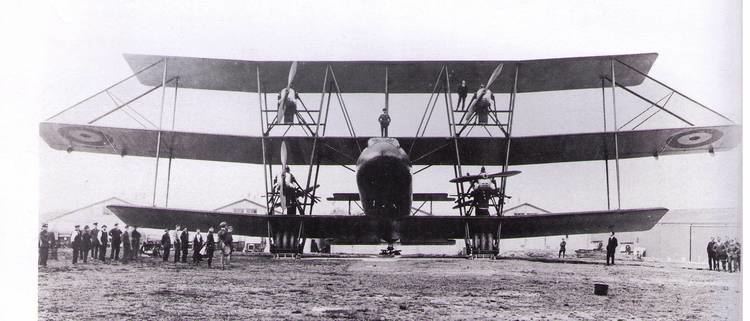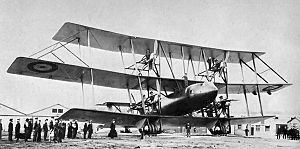Wingspan 40 m First flight May 26, 1919 | Length 22 m Manufacturer Walter George Tarrant | |
 | ||
Tarrant tabor
The Tarrant Tabor was a British triplane bomber designed towards the end of the First World War and was briefly the world's largest aircraft. It crashed, with fatalities, on its first flight.
Contents

Development

The Tabor was the first and only aircraft design produced by W.G Tarrant Ltd, a well-known property developer and building contractor at Byfleet, Surrey, who hired Walter Barling from the Royal Aircraft Factory to design a very large long-range heavy bomber.

Construction was primarily in wood with conventional tri-plane strut-braced wings and a monocoque fuselage built up from ply veneers.

The Tabor was originally planned as a biplane powered by four 600 hp Siddeley Tiger engines. However delays in development of the engines meant these would be unavailable and so the aircraft was redesigned to use six 450 hp Napier Lion engines to give a similar power/weight ratio, and a third, upper wing added.

The final design had a wingspan of over 131 ft (40 m), with the central wing of much greater span than the other two. Four engines were mounted in push pull configuration pairs between the lower and middle wings with the other two mounted in tractor configuration between the middle and upper wings, directly above the lower pairs. The tractor engines used two-bladed propellors, the pushers four-bladed ones. With the end of the war conversion to a passenger aircraft was planned.
The monocoque construction gave a large open space within the fuselage. The pilots were situated in the nose, with a partition separating them from the engineer's station and the engine controls mounted on either side of the opening in the partition. The fuel tanks were in the top and sides of the fuselage to maintain the clear internal space.
Work on the aircraft had stopped at then end of the First World War, when it was no longer needed as a bomber . It was later completed with the design altered to allow it to be used as a commercial or transport aircraft.
The Tabor's maiden flight was from the Royal Aircraft Establishment at Farnborough on 26 May 1919. The Tabor, with two pilots and five passengers was taxied around the landing field using only the four lower engines. Satisfied with the behaviour of the aircraft the crew decided to take-off. The tail was off the ground but it was still running on the main wheels, intermittently lifting off . When the top two engines were started the aircraft pitched forward, burying the nose into the ground and seriously injuring all on board. The second pilot died after reaching hospital and the pilot died of his injuries a few days later.
Later analysis suggested that the upper engines were so far above the fuselage that they forced the nose down when driven up to full power. The situation may not have been helped by the addition of 1,000 lb of lead ballast in the nose against the wishes of Tarrant.
Operators
Specifications (estimated)
Data from The British Bomber since 1914
General characteristics
Performance
Armament
